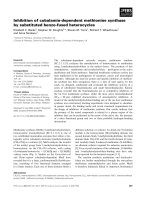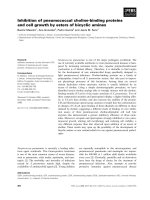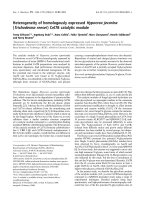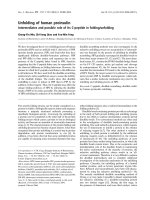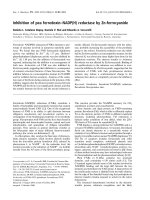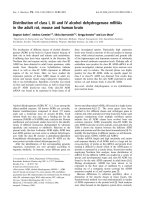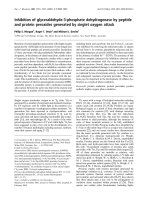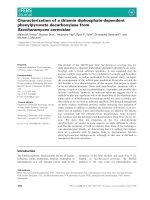Báo cáo khoa học: Inhibition of Hsp90 function delays and impairs recovery from heat shock ppt
Bạn đang xem bản rút gọn của tài liệu. Xem và tải ngay bản đầy đủ của tài liệu tại đây (634.48 KB, 13 trang )
Inhibition of Hsp90 function delays and impairs recovery
from heat shock
Roger F Duncan
1,2
1 Department of Molecular Pharmacology and Toxicology, University of Southern California School of Pharmacy, Los Angeles, CA, USA
2 Department of Molecular Microbiology and Immunology, University of Southern California School of Medicine Los Angeles, CA, USA
Exposure of cells to stress inactivates proteins and can
result in cell death, unless protective responses occur
[1,2]. Virtually all living organisms from bacteria to
humans counteract the detrimental effects of cell stress
by inducing a highly conserved response, termed the
heat shock response or stress response [3]. The
response was initially described and detailed in heat
shocked Drosophila cells [4,5], among others. Subse-
quent studies have shown that a wide array of stressful
circumstances, including oxidative stress, abnormal
protein accumulation, and endoplasmic reticulum per-
turbations, induce a coordinated molecular response
with two distinct facets: first, many metabolic proces-
ses, including mRNA processing and translation, are
severely inhibited, presumably to minimize the accu-
mulation of deleterious protein forms. Second, there is
a massive, rapid synthesis of a small group of proteins
termed the heat shock proteins (Hsps), or stress pro-
teins, that requires unique transcriptional induction
and mRNA processing, and preferential translation [3].
A key feature of the heat shock response is its sup-
pression following restoration of normal environmental
conditions [3,6]. This entails the restoration of normal
metabolic functions, such as protein synthesis, termin-
ation of Hsp synthesis, and reduction in Hsp abun-
dance. The latter features appear to be required
Keywords
geldanamycin; heat shock; herbimycin;
Hsp90; Hsp function
Correspondence
R. F. Duncan, School of Medicine,
Department of Molecular Microbiology
and Immunology, University of Southern
California School of Pharmacy Los Angeles,
CA, USA
Fax: +1 323 442 1681
Tel: + 323 442 1449
E-mail:
(Received 6 July 2005, accepted 17 August
2005)
doi:10.1111/j.1742-4658.2005.04921.x
The induction of the heat shock response as well as its termination is auto-
regulated by heat shock protein activities. In this study we have investi-
gated whether Hsp90 functional protein levels influence the characteristics
and duration of the heat shock response. Treatment of cells with several
benzoquinone ansamycin inhibitors of Hsp90 (geldanamycin, herbimycin A)
activated a heat shock response in the absence of heat shock, as reported
previously. Pretreatment of cells with the Hsp90 inhibitors significantly
delayed the rate of restoration of normal protein synthesis following a brief
heat shock. Concurrently, the rate of Hsp synthesis and accumulation was
substantially increased and prolonged. The cessation of heat shock protein
synthesis did not occur until the levels of Hsp70 were substantially elevated
relative to its standard threshold for autoregulation. The elevated levels of
Hsps 22–28 (the small Hsps) and Hsp70 are not able to promote thermo-
tolerance when Hsp90 activity is repressed by ansamycins; rather a suppres-
sion of thermotolerance is observed. These results suggest that a
multicomponent protein chaperone complex involving both Hsp90 and
Hsp70 signals the cessation of heat shock protein synthesis, the restoration
of normal translation, and likely the establishment of thermotolerance.
Impaired function of either component is sufficient to alter the heat shock
response.
Abbreviations
2DGE, two-dimensional IEF ⁄ SDS ⁄ PAGE; eIF, eukaryotic initiation factor; EMSA, electrophoretic mobility shift assay; HSF, heat shock
transcription factor; Hsp, heat shock protein; PI3K, phosphatidylinositol 3-kinase; SM, Schneider’s Drosophila growth medium.
5244 FEBS Journal 272 (2005) 5244–5256 ª 2005 FEBS
because some Hsps are detrimental to normal growth
and hence are sequestered or degraded during recovery
[3,7]. Molecular programs that regulate the termination
of the heat shock response thus significantly influence
cellular and organismal health.
The accumulation of a threshold level of Hsp70 sig-
nals the cessation of Hsp mRNA transcription and the
restoration of the normal rate of protein synthesis.
This has been termed ‘autoregulation’ of the stress
response, and is proposed to reflect the ability of Hsps
to inhibit the heat shock transcription factor (HSF)
[6,8,9]. Hsp70-dependent autoregulation of the stress
response has been amply documented in cells from
yeast to Drosophila to humans [8,10,11].
In this study we have investigated whether and how
Hsp90 influences the duration or characteristics of the
stress response, about which little is known to date.
Hsp90 has been directly implicated in the regulation of
HSF, partnering with Hsp70 to control its activity [12].
Through application of benzoquinone ansamycin anti-
biotics that compete with ATP for the Hsp90 nucleotide
binding site and inhibit Hsp90 activity [13,14], the
role(s) of Hsp90 in the heat shock response can be
straightforwardly investigated. We find that in Droso-
phila cells latent HSF is activated by Hsp90 inhibition
leading to a ‘heat shock response’ in the absence of
stress, as reported previously for other cell types. When
ansamycin-treated cells are heat shocked, the restoration
of a normal metabolic function, protein synthesis, is sig-
nificantly repressed, even though supra-physiological
levels of Hsp70 accumulate due to the failure of these
cells to terminate the heat shock response. In the absence
of Hsp90 function cells cannot establish a thermo-
tolerant state, even with the accentuated abundance of
the other classes of Hsps. It has been well-established
that Hsp70 collaborates with Hsp90 to carry out many
of its chaperone functions [15,16], and these results indi-
cate that such collaboration is required for efficient
cessation of the heat shock response.
Results
Benzoquinone ansamycins induce a heat shock
response in the absence of heat shock
We hypothesize that Hsp90 function regulates facets of
the heat shock response, as has been documented for
Hsp70 [3,6,8]. Ansamycin Hsp90 inhibitors were used
to determine whether two key elements of the heat
shock response – (a) induction and suppression of heat
shock protein synthesis, and (b) normal protein synthe-
sis recovery – were altered when Hsp90 function was
abrogated. Initially, the effects of ansamycins on non-
heat protein synthesis rate and type were examined to
exclude the possibility that effects observed during
recovery from heat shock resulted from a general inhi-
bition of the translational machinery. First, there was
no overall inhibition or activation of translation rate
as assessed by trichloroacetic acid (TCA) precipitation
of pulse-labeled protein over 6 h of treatment (data
not shown) and IEF ⁄ SDS ⁄ PAGE analysis (Fig. 1),
thus excluding the possibility that a deficit in protein
synthesis recovery from heat shock could be due to a
direct effect of the inhibitors on the translational
machinery. Second, there is a striking synthetic induc-
tion of a limited number of proteins (Fig. 1). Benzo-
quinone antibiotics induce the expression of heat
shock proteins at the transcriptional level in mamma-
lian cells, presumably because Hsp90 sequesters HSF
in an inactive state [17–19]. Our results show the same
induction of Hsps occurs in Drosophila, based on the
precise comigration of the ansamycin-induced proteins
with heat-induced proteins. Similar results were
obtained with both ansamycins: geldanamycin
Fig. 1. Ansamycins induce Hsp synthesis in the absence of heat shock in Drosophila cells. Drosophila S2 cells were incubated with
1 lgÆmL
)1
geldanamycin or 1 lM herbimycin A, or left untreated. Cells were pulse-labeled for 15 min at intervals with 20 lCiÆmL
)1
[
35
S]methionine. Protein samples were prepared as described for 2DGE (see Experimental procedures) and analyzed by IEF ⁄ SDS ⁄ PAGE.
Equal amounts of protein (equal cell numbers) were loaded onto each first dimension gel (based on Bradford assays, and confirmed by Co-
omassie Brilliant Blue staining of the gels after electrophoresis). Labeled proteins were detected by autoradiography. The basic region of the
gel is to the right, the acidic end to the left. Cells labeled after 6 h incubation without (A) or with (B) geldanamycin. (C, D) Cells labeled after
2 h incubation with or without herbimycin A. Only sectors containing Hsp70 ⁄ 68 (left sectors in C, D) and Hsp22 ⁄ 23 (right sectors in C, D)
are shown. (E) EMSA analysis of ansmycin-treated and heat shocked cells. Whole cell lysates were prepared from cultures treated without
or with herbimycin A, as well as a positive control heat-shocked culture. Each lysate was incubated with a
32
P-labeled DNA probe containing
the HS element, analyzed by PAGE and autoradiography [41]; only the region corresponding to the migration of protein-bound, retarded
mobility probe is shown. (F) Northern analysis. RNA was extracted from cultures treated without or with herbimycin A for 3 h, displayed by
formaldehyde ⁄ agarose gel electrophoresis, probed with a
32
P-labeled DNA probe for Hsp70, and visualized by autoradiography. Only the
region corresponding to the migration of Hsp70 mRNA is shown. (G) Western EMSA analysis of HSF phosphorylation. Extracts were pre-
pared from cells treated with geldanamycin (upper) or herbimycin A (lower) were analyzed by SDS ⁄ PAGE and immunoblotting with anti-HSF
sera; retarded bands have been correlated with HSF phosphorylation and activation [22]. An extract from cells heat shocked for 30 min at
36 °C is shown at the lower right, for reference. (P)HSF, phosphorylated HSF isoforms. nsb, nonspecific band.
R. F. Duncan Ansamycins inhibit heat shock recovery
FEBS Journal 272 (2005) 5244–5256 ª 2005 FEBS 5245
(Fig. 1A,B) and herbimycin A (Fig. 1C,D). The activa-
tion of Hsp transcription by ansamycins at normal
temperature is not subject to autoregulation as little to
no difference in Hsp synthetic rate was observed
between 2 and 6 h of treatment; e.g. panel B shows
abundant Hsp synthesis after 6 h of treatment based
on pulse-label analysis. Notably, as will be detailed
subsequently, suppression of Hsp synthesis is observed
when ansamycin-treated cells are heat shocked, then
recovered. The activation of HSF was confirmed by
DNA-binding gel shift assay (Fig. 1E) and northern
blot analysis using Hsp70 probes (Fig. 1F). Curiously,
HSF phosphorylation, which is frequently used as a
surrogate marker for HSF activation, was not detected
following ansamycin treatment and robust Hsp tran-
scription (Fig. 1G), though phosphorylated isoforms
can be readily detected following heat shock (Fig. 1G,
lower right lane).
A
B
F
G
E
C
D
Ansamycins inhibit heat shock recovery R. F. Duncan
5246 FEBS Journal 272 (2005) 5244–5256 ª 2005 FEBS
We were also interested to determine if evidence for
Hsp90-mediated regulation of expression of other
genes, either at a transcriptional or translational level,
could be discerned that might implicate other path-
ways that could influence the heat shock response.
However, careful comparative examination of the 2D
IEF ⁄ SDS ⁄ PAGE spot patterns of several untreated
and treated samples failed to uncover any additional
reproducibly altered spots (e.g. Fig. 1A,B).
Benzoquinone ansamycins delay heat shock
recovery and prolong Hsp synthesis
To determine whether Hsp90 function affects
characteristics of the heat shock response,
geldanamycin-treated Drosophila S2 cells were heat
shocked for 30 min at 36 °C, then restored to their nor-
mal growth temperature. Samples were pulse-labeled
for 15 min with [
35
S]methionine ⁄ cysteine at intervals
during heat shock and recovery. In keeping with the
observation that geldanamycin did not inhibit protein
synthesis per se, no difference in protein synthesis rate
during heat shock or early in the recovery phase was
observed (Fig. 2A).
However, geldanamycin treatment causes a modest
inhibition of protein synthesis rate during later recov-
ery that is more evident at 3–4 h (Fig. 2A; at recovery
times of 2 h and thereafter differences between
untreated and ansamycin-treated cells were signifi-
cantly negative at the P ¼ 0.05 level based on a paired
t-test). As will be described, this overall measurement
significantly underestimates the delay in recovery,
because the synthesis of heat shock proteins dominates
the overall measurement. Recovery rates for specific
nonheat shock mRNA translation requires more pre-
cise analysis, as will be presented below. Herbimycin
treatment during heat shock and recovery produced
results indistinguishable from those obtained with gel-
danamycin (data not shown). To begin to address how
the translation of specific mRNAs was affected, pulse-
labeled samples were analyzed by one-dimensional
SDS ⁄ PAGE. This provides an informative overview of
translational changes, but is insufficient to accurately
quantify individual protein synthetic changes. Several
features stand out. First, the duration of heat shock
protein synthesis is extended (Fig. 3); this is most evi-
dent in the Hsp70 band, though detectable for all clas-
ses of Hsp synthesis. Second, there is a delay in the
restoration of normal translation. This is most evident
in the 1D analysis in lanes wherein significant restor-
ation is just beginning, e.g. in the 2 h recovery samples
in Fig. 3B. These two events are likely coupled and
both result from inadequate Hsp90 activity.
To precisely characterize and quantify the influence
of ansamycin treatments on normal translation recov-
ery and Hsp synthesis, cells were pulse-labeled as des-
cribed and proteins analyzed by two-dimensional
IEF ⁄ SDS ⁄ PAGE, autoradiography, and densitometry
(Fig. 4). From a qualitative perspective a significant
impairment in normal translation restoration is evident
in the reduced intensity of virtually all nonheat protein
spots. To provide quantitative data a random sample of
A
B
Fig. 2. Ansamycin treatment suppresses the recovery of normal pro-
tein synthesis following heat shock. Drosophila S2 cells were pre-
treated with ansamycin for 10 min, then heat shocked in a water
bath equilibrated to 36 °C for 30 min, then returned to normal growth
temperature for the duration of the experiment. Aliquots were pulse-
labeled for 15 min with 20 lCiÆmL
)1
[
35
S]methionine at intervals. (A)
Protein samples prepared as described (see Experimental proce-
dures) were quantified for incorporation by TCA precipitation on
GF ⁄ C filters and liquid scintillation counting. Results represent the
average and standard deviation of 3–5 replicates with values from
geldanamycin- and herbimycin A-treated samples combined. (B) Spe-
cific protein synthesis was quantified by 2D IEF ⁄ SDS ⁄ PAGE, auto-
radiography, and densitometry of an array of 14 nonheat shock
protein spots (black bars; see Fig. 4 for identification) from samples
pulse-labeled 3 h into recovery.
R. F. Duncan Ansamycins inhibit heat shock recovery
FEBS Journal 272 (2005) 5244–5256 ª 2005 FEBS 5247
spots (identified in Fig. 4A) was measured by densito-
metry; the extent to which recovery of these spots was
retarded is reported in Fig. 2B. For spots 1–9, the range
of inhibition is 70–95%, with an average of 81%
(black bars). Recovery of a minor class of spots was less
affected by ansamycin treatment. Selected members of
this group, labeled a-e, were inhibited only 40–60%
(right five gradient-filled bars). In summary, ansamycin
treatment significantly delays restoration of cell func-
tion following heat shock, implicating Hsp90 activity in
this process.
Heat shock proteins 90, 70, 22 and 23 were similarly
quantified. The rate of synthesis of these proteins
achieves a higher maximum and remains activated
longer in the ansamycin-treated cells (Fig. 4C–I; gel
sectors are shown in panels C–E, and densitometric
quantitation in panels F–I). For example, Hsp70 synthe-
sis rapidly achieves its maximum synthetic rate in
untreated cells at 1–2 h, and then rapidly declines,
whereas in ansamycin-treated cells its synthetic rate at
2 h is approximately threefold elevated relative to
untreated cells, and its synthesis at 3 h remains high,
AB
Fig. 3. Ansamycin effects on Hsp synthesis and normal protein synthesis recovery analyzed by SDS ⁄ PAGE. Cells were treated and labeled
as described in Fig. 2, legend. Extracts were prepared using hSDS buffer (see Experimental procedures) and analyzed by SDS ⁄ PAGE and
autoradiography. Equal amounts of protein (equal cell numbers) were loaded into each lane (based on Bradford assays, and confirmed by
Coomassie Brilliant Blue staining of the gel after electrophoresis). (A) Cells pretreated with (right) or without (left) 1 lgÆmL
)1
geldanamycin.
(B) Cells pretreated with (right) or without (left) 1 l
M herbimycin A. The location of bands corresponding to heat shock proteins Hsp83,
Hsp70, Hsp26 ⁄ 28, and Hsp22 ⁄ 23, as well as actin, are indicted to the right. The extent of induction of Hsp90 during recovery varies; the
herbimycin panels (without, with treatment) represent an example of extensive induction, which is not due to the herbimycin treatment itself
(as it is equally observed in the untreated portion of the panel). This analysis has been repeated in part or completely three times; a repre-
sentative result is shown.
Fig. 4. Ansamycin effects on Hsp synthesis and normal protein synthesis recovery analyzed by 2-dimensional IEF ⁄ SDS ⁄ PAGE. Cells were
treated and labeled as described in Fig. 2, legend. Protein samples were prepared as described for 2DGE (see Experimental procedures) and
analyzed by IEF ⁄ SDS ⁄ PAGE. Equal amounts of protein (equal cell numbers) were loaded onto each first dimension gel (based on Bradford
assays, and confirmed by Coomassie Brilliant Blue staining of the gels after electrophoresis), exposed to film and labeled proteins detected
by autoradiography. For quantitation, films were scanned with a densitometer, and the intensity of spots determined using the Labworks
software (UV Products). The basic region of the gel is to the right, the acidic end to the left. (A, B) Cells treated without or with herbimycin
A beginning 10 min prior to heat shock ⁄ recovery; the 3 h recovery samples are shown. The location of spots corresponding to heat shock
proteins Hsp90, Hsp70, Hsp26 ⁄ 28, and Hsp22 ⁄ 23, and nonheat shock protein actin, are indicated with arrows. These presentations are
overexposed relative to the ones used for densitometric quantification (panels F–I, and Fig. 2B) to emphasize nonheat shock protein synthe-
sis. Correspondingly, Hsp synthetic differences are significantly underrepresented due to film saturation. 14 nonheat shock protein spots
used for monitoring nonheat shock protein recovery are indicated in panel A with numbers, letters above the spots (with the exception of
‘9’, which is written to the right of the spot); see text for details. (C–E) Sectors from 2D gels analyzing protein labeled at the indicated times.
(F–I) Densitometric quantitation of Hsp synthesis. Black bars, without treatment; gradient-filled bars, ansamycin-treated.
Ansamycins inhibit heat shock recovery R. F. Duncan
5248 FEBS Journal 272 (2005) 5244–5256 ª 2005 FEBS
C
AB
DE
GF
HI
R. F. Duncan Ansamycins inhibit heat shock recovery
FEBS Journal 272 (2005) 5244–5256 ª 2005 FEBS 5249
similar to the rate in untreated cells 1–2 h earlier (and
fourfold higher than the rate in untreated cells at
3 h). For the other Hsps the onset of repression during
the recovery interval is delayed relative to untreated
cells, such that the maximum rate is synthesis occurs
1–2 h later. These elevated synthetic rates result in
increased Hsp accumulation, as described in the next
section.
The prolonged rate of Hsp protein synthesis is paral-
leled by a prolonged activation of the heat shock tran-
scription factor HSF, as assessed by HSF
phosphorylation (Fig. 5). Slower migrating HSF iso-
forms are induced by heat shock and increase to 1h
of recovery, then rapidly decline such that they are no
longer detectable by 3 h recovery (Fig. 5A). On the
other hand, phosphorylated HSF isoforms peak later
(at 2 h into recovery) in ansamycin-treated cells,
and remain in their activated form after they have
disappeared from the untreated cells. These results
confirm that ansamycins cause a prolongation of the
heat shock response, which can be considered a deficit
in autoregulation as Hsp70 levels are high.
Notably, the transcription and translation of Hsp70
mRNA is largely suppressed by 5 h recovery in ansa-
mycin-treated cells exposed to heat shock ⁄ recovery,
whereas in cells exposed to ansamycin treatment at
normal temperature its gene expression continues un-
abated (Fig. 1). This suggests that high levels of Hsp70
are sufficient to suppress HSF activity even in the
absence of Hsp90, albeit less efficiently than in its pres-
ence. Similarly, restoration of normal metabolic func-
tion (e.g. protein synthesis) occurs in the absence of
Hsp90 function, but with delayed kinetics.
The abundance of Hsps ultimately determines their
functional significance. The influence of ansamycins on
Hsp abundance during heat shock recovery was deter-
mined by Coomassie staining 2DGE-resolved proteins,
and densitometry. Throughout the first hours of recov-
ery no significant differences in abundance of any Hsp
was observed (data not shown), consistent with the sim-
ilar rates of synthesis. Protein abundance at times cor-
responding to the maximum Hsp accumulation (4–5 of
recovery) showed modest to significantly elevated levels
of Hsps (Fig. 6). For Hsp70, the major Drosophila heat
shock protein and the one that primarily determines
heat shock sensitivity and resistance, ansamycin treat-
ment increased its levels by approximately threefold
(see also Fig. 7, inset, for confirmation by western blot
analysis). Hsp22 was approximately twofold increased,
whereas Hsp23 and Hsp90 were 20–40% increased.
These results suggest that ansamycins might enhance
thermotolerance, with the caveat that Hsp90 is non-
functional and might mitigate benefits provided by
higher levels of the other Hsp classes. This issue is
addressed in the next section.
Benzoquinone ansamycins decrease thermotoler-
ance
To determine whether the increased Hsp abundance
caused by ansamycin treatment had functional conse-
quences on cells’ ability to tolerate stress, restoration of
cell proliferation following a moderately severe chal-
lenge heat shock (30 min at 38 °C) was determined, with
or without ansamycin pretreatment. As noted above the
contrasting influences of various Hsp classes could
AB
Fig. 5. Ansamycin prolongs the activity of HSF as assessed by phosphorylation. Cells were treated as described in Fig. 2, legend. Extracts were
prepared using hSDS buffer (see Experimental procedures) and analyzed by SDS ⁄ PAGE and immunoblotting with antisera to Drosophila HSF.
Equal amounts of protein (equal cell numbers) were loaded into each lane (based on Bradford assays, and confirmed by Amido schwartz staining
of the gel after electrophoretic transfer). Cells without (A) or with (B) pretreatment with 1 l
M herbimycin A. Locations of the major HSF band as
well as the more slowly migrating phosphorylated isoforms [(P)HSF] are indicated to the right of panel B. Three to four differentiated bands are
detected on the original film; nsb, nonspecific band.
Ansamycins inhibit heat shock recovery R. F. Duncan
5250 FEBS Journal 272 (2005) 5244–5256 ª 2005 FEBS
produce accentuated thermotolerance, reduced thermo-
tolerance if Hsp90 function is crucial, or no
distinguishable effect if the influences of distinct Hsp
classes counterbalance each other.
Without ansamycin treatment or a tolerance-indu-
cing heat shock (control conditions) cell numbers
progressively increase over several days (Fig. 7, open
triangles; top curve). Addition of ansamycin to the cul-
ture medium at reseeding had no effect, by itself, on
cell growth (open diamond, day 4). Hence its suppres-
sion of cell proliferation, described below, cannot be
ascribed to a basal toxic effect. The heat shock ⁄ recovery
protocol described in previous experiments produces
no distinguishable effect on subsequent cell growth at
normal growth temperature (solid diamonds). The
more severe challenge heat shock modestly delays cell
growth (open squares). In cells that have undergone
a tolerance-inducing heat shock ⁄ recovery cycle, as
detailed in the previous figures, the severe heat shock
appears less detrimental as under these conditions
cells increase in number indistinguishably from wholly
untreated control cells (open circles). In summary,
proliferation under the four cited regimens was
indistinguishable.
If cells are pretreated with ansamycin before the
severe challenge heat shock then cell proliferation is
significantly retarded (solid squares). Under these
conditions modestly elevated levels of Hsps are syn-
thesized, but the activity of Hsp90, and perhaps
Hsp70 indirectly, is repressed. The elevated levels of
Hsps provide no discernable stress-resistance benefits.
If cells are both ansamycin-treated and provided a
priming heat shock-recovery cycle, leading to sub-
stantially higher levels of all Hsps (e.g. Fig. 7, inset),
then the growth retardation is less than with ansa-
mycin treatment alone (compare solid circles (both
A
C
B
Fig. 6. Accumulation of Hsps in ansamycin-treated and untreated cells following heat shock. Cells were treated and labeled as described in
Fig. 2, legend. Protein samples were prepared as described for 2DGE (see Experimental procedures) and analyzed by IEF ⁄ SDS ⁄ PAGE. Equal
amounts of protein (equal cell numbers) were loaded onto each first dimension gel (based on Bradford assays, and confirmed by Coomassie
Brilliant Blue staining of the gels after electrophoresis). Only a sector of the entire gel is shown in the panels. (A) Sectors containing Hsp90
and Hsp70 from samples 4 h and 5 h of recovery from heat shock. The locations of Hsp68 and Grp78 (also referred to as Hsc72 in Droso-
phila) are indicated as well. (B) Sectors containing Hsp22 and Hsp23, as in A. (C) Densitometric quantitation of Hsp abundance. The maxi-
mum amount for each Hsp protein was set to 100%. Black bars, without treatment; gradient-filled bars, ansamycin-treated.
R. F. Duncan Ansamycins inhibit heat shock recovery
FEBS Journal 272 (2005) 5244–5256 ª 2005 FEBS 5251
treatments) to solid squares), but remains distinguish-
ably reduced relative to cells heat shocked ⁄ recovered
in the absence of ansamycin (compare open to solid
circles). Similar results were obtained when the ansa-
mycins were removed after 12 h exposure. Thus,
even though heat shock protein production is accen-
tuated by ansamycin treatment the abundant Hsps
rather correlate with reduced thermotolerance when
Hsp90 is rendered nonfunctional, implicating Hsp90
in restoration of cell proliferation following heat
shock. Because ansamyin did not suppress cell prolif-
eration in nonheat shocked cells, the results suggest
that Hsp90 function is specifically needed to restore
function to critical, heat-impaired targets. Results by
others have suggested that ansamycin-induced Hsp
expression can provide thermotolerance to mamma-
lian cells (e.g. [18]). The discrepant results may
reflect differential reliance on Hsp90 function in
establishing thermotolerance, paralleling observations
that the primary thermotolerance-inducing Hsp dif-
fers between species ⁄ cell type [20].
Discussion
Molecular chaperones have distinct, specific roles in cel-
lular physiology as well as coordinated functions in pro-
tein folding and refolding. In Drosophila, Hsp70 is the
principal stress-induced chaperone and its activity has
been shown to determine many features of the heat
shock response [3]. In particular experimental manipula-
tions that restrict Hsp70 accumulation or activity pro-
long the heat shock response [3,6,8]. In this study we
have addressed the requirement for Hsp90 function dur-
ing the early inductive events of the heat shock response,
in its cessation via autoregulation by Hsps, and for the
activity of Hsps in providing thermotolerance.
The results suggest that Hsp90 activity contributes to all
aspects of the heat shock response, perhaps as part of a
chaperone protein refolding system in coordination with
Hsp70 [15,16,21].
Inhibition of Hsp90 by ansamycins does not influ-
ence normal protein synthesis, either on a global or
protein-specific scale. As reported by others studying
mammalian cells [17–19], ansamycin treatment acti-
vates HSF leading to the production of Hsps in
Drosophila. Intriguingly, this appears to occur in the
absence of detectable HSF phosphorylation, contrary
to other chemically induced activations of HSF such
as are caused by proteasome inhibitors [22]. Suppres-
sion of Hsp90 function prolongs the activity of HSF
and the synthesis of Hsp mRNAs following heat
shock, paralleling the effect of blocking Hsp70 func-
tion. Ultimately, HSF is inactivated suggesting that
Hsp70 is sufficient to autoregulate HSF transcription
even in the absence of Hsp90 function. As a conse-
quence of ansamycin pretreatment, the rate of Hsp
synthesis is maintained for a longer duration and
excess amounts of each of the major classes of Hsps
accumulate. However, the enhanced Hsp complement
does not enhance restoration of cell proliferation fol-
lowing a moderately severe heat shock, but rather sub-
stantially reduces it. This suggests that Hsp90 function
is critical for thermotolerance and heat shock recovery.
This impairment is not a general consequence of
Hsp90 inhibition, as retarded cell growth was only
observed following heat shock, and not in cells main-
tained at their normal growth temperature (the repor-
ted cytotoxic effects of ansamycin treatment on tumor
cells (e.g [23,24]). were not observed in Drosophila S2
cells). Thus, the effects are specific to the refolding of
Fig. 7. Ansamycin-treated cells overexpressing Hsps are sensitized
to cell growth inhibition by heat shock. Drosophila S2 cells were
untreated or treated with ansamycin (Ansa Rx) and ⁄ or heat
shocked in a water bath equilibrated to 36 °C for 30 min followed
by recovery at normal growth temperature for 5 h (PreHS) and ⁄ or
heat shocked in a water bath equilibrated to 38 °C for 30 min (chal-
lenge, or Ch). Following the challenge heat shock (or in its absence
for nonshocked cells) cells were placed in a 23 °C incubator for up
to 4 days. Cell samples were removed at intervals for determin-
ation of cell number by counting in a hemocytometer. The symbol
designations are shown to right of the 4 d points. Experiments
were performed using either geldanamycin (1 lgÆmL
)1
) or herbimy-
cin A (1 l
M); cell counts are combined. The day-by-day analysis for
each condition was repeated three to eight times, and the average
is shown. Deviation for all points overlaps, and so is not presented
for clarity. For the 4 d points the deviations were: No challenge
(n), ± 161; no challenge, PreHS (m), ± 284; PreHs (s), ± 100; chal-
lenge only (h), ± 152; PreHs, Herb Rx (d), ± 191; no PreHs, Herb
Rx (n), ± 152. Cells treated with ansamycin only [e, shown only for
4 d (no PreHS, no challenge)] increased cell numbers indistinguish-
ably from the control cells (‘no challenge: n’). Inset: protein sam-
ples removed after 5 h recovery from the PreHS, or after an
equivalent incubation, without or with ansamycin treatment. (– ⁄ –),
no treatment; (A ⁄ –), ansamycin, no PreHS; (– ⁄ H), PreHS, no ansa-
mycin; (A ⁄ H), ansamycin present prior to PreHS and for the 5 h of
recovery.
Ansamycins inhibit heat shock recovery R. F. Duncan
5252 FEBS Journal 272 (2005) 5244–5256 ª 2005 FEBS
heat-denatured proteins, or some other detrimental
consequence of heat shock.
Inhibition of Hsp90 function by ansamycins also sig-
nificantly delays the recovery of normal, nonheat
shock mRNA translation following heat shock. Global
translation rates are modestly reduced during recovery
(Fig. 2), but nonheat shock mRNA translation rates as
determined by 2DGE analysis of specific protein spots
reveals that the translation of most mRNAs is inhib-
ited by 80% (Fig. 2) during intermediate stages of
recovery ( 1–3 h). The quantitative discrepancy arises
because heat shock mRNAs are super-induced by
ansamycin treatment and constitute the majority of
overall translation, masking the extensive inhibition of
most nonheat shock mRNAs’ translation. A subset
of nonheat shock mRNAs recovers more rapidly.
These translation recovery patterns likely are linked to
molecular events that regulate heat shock-mediated
translation repression and subsequent restoration of
the affected factors to their active state. As the molecu-
lar mechanism for translation inhibition in Drosophila
is not currently known, formulating a more precise
hypothesis becomes speculative. For example, if inhibi-
tion involves diminished eIF4F activity, as substantial
evidence suggests [25–28], then as eIF4F activity is
progressively restored during recovery mRNAs with
the least dependence on eIF4F (e.g. those with rela-
tively unstructured 5¢ untranslated regions) would be
predicted to recover activity earlier. In the event where
eIF4F activity restoration is delayed, as may occur
when chaperone activity is inhibited by ansa-
mycin treatment, mRNAs with very little requirement
for eIF4F, such as the heat shock mRNAs and the
subset of nonheat shock mRNAs with diminished
eIF4F requirements, will be preferentially translated.
Hsp90 functions as a homodimer to fold several key
classes of proteins, including protein kinases and tran-
scription factors [15,16,21]. In these roles it collaborates
with Hsp70-family proteins, which bind to the newly
synthesized proteins and transfer them to the Hsp90
folding machine via the intermediates Hop (for tran-
scription factors) or cdc37 (for protein kinases) for final
folding and stabilization of the activation-primed con-
formation. Numerous specific protein substrates of this
coordinated folding system have been identified, but
with specific regards to protein synthetic events during
the heat shock response the eIF2a protein kinase and
Akt are noteworthy. eIF2 a phosphorylation has been
implicated by many in the repression of protein synthe-
sis during heat shock [25,29–31], and thermotolerance
has been shown to correlate with accelerated restor-
ation of eIF2a to its active state [31]. Hsp70 and Hsp90
association with the heat shock-activated eIF2a kinase
regulates its activity [32,33]. Hence, impairment via
Hsp90 and the ansamycins provides an avenue through
which the heat shock response could be influenced. In
addition, the PI3K ⁄ Akt kinase axis regulates protein
synthesis rate and type in several circumstances, inclu-
ding growth factor stimulation and recovery from stress
[34,35]. Suppressing its activity via ansamycins [36] may
delay recovery from heat shock paralleling the reduc-
tion in recovery from other forms of stress observed by
directly inhibiting targets of Akt such as Tsc2 and
mTOR with U0126 and rapamycin, respectively [35]. A
final potential target of Hsp90 is eIF4F itself, that has
been observed to enter into heavy-sedimenting particu-
late granules in heat-shocked mammalian cells [28,37].
If Hsp90 is involved in resolubilizing eIF4F from par-
ticulate storage granules, and if this is critical for recov-
ery of normal translation, then Hsp90 inhibition by
ansamycin would be predicted to delay restoration fav-
oring the translation of Hsp mRNAs and nonheat
shock mRNAs with relatively low 5¢ untranslated
region secondary structure.
The influence of Hsp90 on heat shock ⁄ recovery is
only moderate, suggesting that the other heat shock pro-
teins that accumulate in supra-physiological amounts in
ansamycin-treated cells can compensate for Hsp90
though less efficiently. This mirrors results in other cir-
cumstances documenting partial redundancy in protein
folding systems, based in part on the ability of an over-
expressed chaperone class to substitute for a deficit in a
wholly different class [21]. The contribution of Hsp90
function to the heat shock response is clearly documen-
ted in this study, though in keeping with previous char-
acterizations of the Drosophila heat shock response
Hsp70 predominates. Considering that both heat and
ansamycin treatments are used as cancer treatments
[38], these results suggest that their coapplication could
provide cooperative, more efficacious cell killing.
Experimental procedures
Chemicals
Chemicals were purchased from Sigma Chemical Company
(St Louis, MO, USA) unless otherwise indicated.
Drug treatment, heat shock, [
35
S]methionine
labeling, and protein extraction and analysis
Schneider S2 cells were cultured at 22–24 °C in Schneider’s
Drosophila Medium (SM; Invitrogen, Inc., Carlsbad, CA,
USA) containing 10% (v ⁄ v) fetal bovine serum, 20 mm
l-glutamine, 100 unitsÆmL
)1
penicillin, 0.1 mgÆmL
)1
strepto-
mycin, 0.25 mgÆmL
)1
amphotericin B (Invitrogen). At the
R. F. Duncan Ansamycins inhibit heat shock recovery
FEBS Journal 272 (2005) 5244–5256 ª 2005 FEBS 5253
start of each labeling experiment cells were scraped from
T25 flasks, pelleted by brief centrifugation (3 min, 850 g)in
a clinical centrifuge (IEC, Needham Heights, MA, USA),
and resuspended in Grace’s media lacking methionine (Invi-
trogen). The cells were then transferred to 20 mL glass scin-
tillation vials, with a stir flea, and allowed to recover for
15 min with stirring prior to analyses (at heat shock, or nor-
mal growth temperature of 22–24 °C). Herbimycin A (1 lm)
or 1 lgÆmL
)1
geldanamycin (both from Calbiochem, San
Diego, CA, USA) [or 0.1% (v ⁄ v) dimethylsulfoxide, mock
treatment, to parallel vehicle concentration] were applied to
cells. For heat shock, after 10 min preincubation a portion
of the cells was transferred to a 36 °C water bath (with stir-
ring) for 15 min, at which time 5 · 10
6
cells (1 mL suspen-
sion) were labeled with 20 lCi [
35
S]methionine ⁄ cysteine
(ICN Biochemicals, Costa Mesa, CA, USA) for 15 min (i.e.
total 30 min heat shock). No treatment samples were labeled
concurrently at normal growth temperature. After labeling,
cells were pelleted (15 s microcentrifuge at 16 000 g), re-
suspended in and washed twice with 4 °C wash buffer
(50 mm KCL, 15 mm MgSO
4
,4mm CaCl
2
,3mm KH
2
PO
4
,
10 mm dextrose, 8.4 mm Hepes pH 7.2, and 20 lgÆmL
)1
cy-
cloheximide) by centrifugation. After the final centrifugal
wash, the cell pellet was lysed with (for two-dimensional gel
analyses) 100–150 lL of ampholyse buffer [ 9.8 m urea,
5% 3.5–10 Biolytes (Bio-Rad, Hercules, CA, USA), 2%
(v ⁄ v) Nonidet P-40 (NP-40), 1% (v ⁄ v) 2-mercaptoethanol],
microcentrifuged for 3 min at top speed (Eppendorf, Brink-
man Instruments, NY, USA), and the supernatant recovered
to give a final protein concentration of 2mgÆmL
)1
. Pro-
tein concentration was measured by Bradford Assay (Bio-
Rad), and radioactivity per lg protein was measured by
TCA precipitation. For samples to be analyzed by 1D gel
electrophoresis (with or without immunoblotting), washed
protein pellets were lysed in hSDS (0.3% SDS, 50 mm Tris
pH 8.0, 1% (v ⁄ v) 2-mercaptoethanol, at 98 °C). The pellet
was disrupted by pipeting. 1 ⁄ 20 volume of RNase ⁄ DNase
solution (5 mgÆmL
)1
DNase, 2.5 mgÆmL
)1
RNase A,
500 mm Tris pH 7.0, 50 mm MgCl
2
) was added for 1 min,
viscosity reduced by pipeting, then 1 ⁄ 4 volume of 4 · Lae-
mmli-formula SDS ⁄ PAGE buffer was added. Protein con-
centration was determined by Bradford assay (Bio-Rad) and
equal lg samples analyzed on standard Laemmli 1D
13 cm separating gels. Gels were either processed as des-
cribed in the next section, for radiolabeled samples, or elect-
rophoretically transferred to PVDF (Immobilon P,
Millipore Corp., Billerica, MA, USA) and analyzed with
protein-specific antisera following Amersham’s ECL recom-
mended protocol (Piscataway, NJ, USA).
Analysis of proteins by two-dimensional
isoelectric focusing ⁄ SDS⁄ PAGE
Two-dimensional IEF ⁄ SDS ⁄ PAGE was performed basically
as described by O’Farrell [39], with modifications as
described by Duncan and Hershey [40] to promote spot
focusing. Gels were fixed, dried, and exposed to Kodak
X-OMAT film (Rochester, NY, USA) for 4–15 days. Pro-
tein bands ⁄ spots were quantitated by densitometry (Lab-
Works; UVP, Upland, CA, USA).
Cell number assay
Approximately 10
7
cells were incubated with vehicle or ansa-
mycin. After 15 min, some cultures were heat shocked at
36 °C for 30 min in a water bath, after which time all cultures
were incubated a further 5 h at 22–24 °C. Aliquots of protein
were removed 5 h recovery to assess heat shock protein
induction by western blot analysis. Some cultures were then
heat shocked at 38 °C for 30, after which time the cell density
was reduced to 10
6
cellsÆmL
)1
by dilution with SM contain-
ing 10% (v ⁄ v) fetal bovine serum, plated at 10
5
cells per
well in a 24 well plate, and incubated at 23 °C for the dur-
ation of the experiment. After the cells had attached, the
medium (containing ansamycin in some wells) was removed
and replaced with SM containing 10% (v ⁄ v) fetal bovine
serum. Cells were scraped from the well at 24 h intervals and
counted in a hemacytometer. Cell density at time of plating
(day 0) was also determined.
Acknowledgements
This research was supported by NSF grant MCB-
9728753. We thank Dr Bryan Langholz for assistance
with statistical analyses.
References
1 Parsell DA & Lindquist S (1993) The function of
heat -shock proteins in stress tolerance: degradation
and reactivation of damaged proteins. Ann Rev Genet
27, 437–496.
2 Gabai VL & Sherman MY (2002) Interplay between
molecular chaperones and signaling pathways in
survival of heat shock. J Appl Physiol 92, 1743–1748.
3 Lindquist S (1986) The heat -shock response. Ann Rev
Biochem 55, 1151–1191.
4 Ritossa FM (1962) A new puffing pattern induced by
temperature shock and DNP in Drosophila. Experientia
18, 571–573.
5 Tissieres A, Mitchell HK & Tracy WM (1974) Protein
synthesis in salivary glands of Drosophila melanogaster:
relation to chromosome puffs. J Mol Biol 84 , 389–398.
6 Solomon JM, Rossi JM, Golic K, McGarry T & Lind-
quist S (1991) Changes in hsp70 alter thermotolerance
and heat -shock regulation in Drosophila. New Biol 3,
1106–1120.
7 Li D & Duncan RF (1995) Rapid turnover of heat
shock protein 70 in Drosophila: stabilization during
Ansamycins inhibit heat shock recovery R. F. Duncan
5254 FEBS Journal 272 (2005) 5244–5256 ª 2005 FEBS
heat shock,and consequent effects on accumulation. Eur
J Biochem 231, 454–465.
8 DiDomenico BJ, Bugaisky GE & Lindquist S (1982)
The heat shock response is self-regulated at both the
transcriptional and post-transcriptional levels. Cell 31,
593–603.
9 Morimoto RI (1998) Regulation of the heat shock
transcriptional response: cross talk between a family of
heat shock factors, molecular chaperones, and negative
regulators. Genes Dev 12, 3788–3796.
10 Stone DE & Craig EA (1990) Self-regulation of 70-kilo-
dalton heat shock proteins in Saccharomyces cerevisiae.
Mol Cell Biol 10, 1622–1632.
11 Mizzen LA & Welch WJ (1988) Characterization of the
thermotolerant cell. I. Effects on protein synthesis activ-
ity and the regulation of heat-shock protein 70 expres-
sion. J Cell Biol 106, 1105–1116.
12 Zou J, Guo Y, Guettouche T, Smith DF & Voellmy R
(1998) Repression of heat shock transcription factor
HSF1 activation by HSP90 (HSP90 complex) that
forms a stress-sensitive complex with HSF1. Cell 94,
471–480.
13 Prodromou C, Roe SM, O’Brien R, Ladbury JE, Piper
PW & Pearl LH (1997) Identification and structural
characterization of the ATP ⁄ ADP-binding site in the
Hsp90 molecular chaperone. Cell 90, 65–75.
14 Grenert JP, Sullivan WP, Fadden P, Haystead TA,
Clark J, Mimnaugh E et al. (1997) The amino-terminal
domain of heat shock protein 90 (hsp90) that binds
geldanamycin is an ATP ⁄ ADP switch domain that regu-
lates hsp90 conformation. J Biol Chem 272,
23843–23850.
15 Pratt WB (1993) The role of heat shock proteins in
regulating the function, folding, and trafficking of the
glucorticoid receptor. J Biol Chem 268, 21455–21458.
16 Pratt WB & Toft DO (2003) Regulation of signaling pro-
tein function and trafficking by the hsp90 ⁄ hsp70-based
chaperone machinery. Exp Biol Med 228, 111–133.
17 Murakami Y, Uehara Y, Yamamoto C, Fukazawa H &
Mizuno S (1991) Induction of hsp 72 ⁄ 73 by herbimycin
A, an inhibitor of transformation by tyrosine kinase
oncogenes. Exp Cell Res 195, 338–344.
18 Hegde RS, Zuo J, Voellmy R & Welch WJ (1995) Short
circuiting stress protein expression via a tyrosine kinase
inhibitor, herbimycin A. J Cell Physiol 165, 186–200.
19 Lawson B, Brewer JW & Hendershot LM (1998) Gelda-
namycin, an hsp90 ⁄ GRP94-binding drug, induces
increased transcription of endoplasmic reticulum (ER)
chaperones via the ER stress pathway. J Cell Physiol
174, 170–178.
20 Sanchez Y & Lindquist SL (1990) HSP104 required for
induced thermotolerance. Science 248, 1112–1115.
21 Young JC, Agashe VR, Siegers K & Hartl FU (2004)
Pathways of chaperone-mediated protein folding in the
cytosol. Nat Rev Mol Cell Biol 5, 781–791.
22 Kim D, Kim SH & Li GC (1999) Proteasome inhibitors
MG132 and lactacystin hyperphosphorylate HSF1 and
induce hsp70 and hsp27 expression. Biochem Biophys
Res Comm 254, 264–268.
23 Bagatell R, Paine-Murrieta GD, Taylor CW, Pulcini EJ,
Akinaga S, Benjamin IJ & Whitesell L (2000) Induction
of a heat shock factor 1-dependent stress response alters
the cytotoxic activity of hsp90-binding agents. Clin
Cancer Res 6, 3312–3318.
24 Bagatell R, Khan O, Paine-Murrieta G, Taylor CW,
Akinaga S & Whitesell L (2001) Destabilization of
steroid receptors by heat shock protein 90-binding
drugs: a ligand-independent approach to hormonal
therapy of breast cancer. Clin Canc Res 7, 2076–
2084.
25 Duncan R & Hershey JWB (1984) Heat-shock induced
translational alterations in HeLa cells: initiation factor
modifications and the inhibition of translation. J Biol
Chem 259, 11882–11889.
26 Panniers R, Stewart EB, Merrick WC & Henshaw EC
(1985) Mechanism of inhibition of polypeptide chain
initiation in heat-shocked Ehrlich cells involves reduc-
tion of eukaryotic initiation factor 4F activity. J Biol
Chem 260, 9648–9653.
27 Hess MA & Duncan RF (1996) Sequence and structure
determinants of Drosophila Hsp70 mRNA translation:
5¢-UTR secondary structure specifically inhibits heat
shock protein mRNA translation. Nucleic Acids Res 24,
2441–2449.
28 Cuesta R, Laroia G & Schneider RJ (2000) Chaperone
hsp27 inhibits translation during heat shock by binding
eIF4G and facilitating dissociation of cap-initiation
complexes. Genes Dev 14, 1460–1470.
29 Scorsone KA, Panniers R, Rowlands AC & Henshaw
EC (1987) Phosphorylation of eukaryotic initiation
factor 2 during physiological stresses which affect pro-
tein synthesis. J Biol Chem 262, 14538–14543.
30 Murtha-Riel P, Davies MV, Scherer BJ, Choi SY,
Hershey JW & Kaufman RJ (1993) Expression of a
phosphorylation-resistant eukaryotic initiation factor
2 alpha-subunit mitigates heat shock inhibition of pro-
tein synthesis. J Biol Chem 268, 12946–12951.
31 Chang GC, Liu R, Panniers R & Li GC (1994) Rat
fibroblasts transfected with the human 70-kDa heat
shock gene exhibit altered translation and eukaryotic
initiation factor 2 alpha phosphorylation following heat
shock. Int J Hyperthermia 10, 325–337.
32 Matts RL, Xu Z, Pal JK & Chen J-J (1992) Interactions
of the heme-regulated eIF-2a kinase with heat shock
proteins in rabbit reticulocyte lysates. J Biol Chem 267,
18160–18167.
33 Rose DW, Welch WJ, Kramer G & Hardesty B (1989)
Possible involvement of the 90-kDa heat shock protein
in the regulation of protein synthesis. J Biol Chem 264,
6239–6244.
R. F. Duncan Ansamycins inhibit heat shock recovery
FEBS Journal 272 (2005) 5244–5256 ª 2005 FEBS 5255
34 Mendez R, Myers MGJ, White MF & Rhoads RT
(1996) Stimulation of protein synthesis, eukaryotic
translation factor eIF4E phosphorylation, and PHAS-I
phosphorylation by insulin requires insulin receptor sub-
strate 1 and phosphatidylinositol 3-kinase. Mol Cell Biol
16, 2857–2864.
35 Naegele S & Morley SJ (2004) Molecular cross-talk
between MEK1 ⁄ 2 and mTOR signaling during recovery
of 293 cells from hypertonic stress. J Biol Chem 279,
46023–46034.
36 Basso AD, Solit DB, Chiosis G, Giri B, Tsichlis P &
Rosen N (2002) Akt forms an intracellular complex
with heat shock protein 90 (Hsp90) and Cdc37 and is
destabilized by inhibitors of Hsp90 function. J Biol
Chem 277, 39858–39866.
37 Kedersha N, Chen S, Gilks N, Li W, Miller IJ, Stahl J
& Anderson P (2002) Evidence that ternary complex
(eIF2-GTP-tRNA (i) (Met)-deficient preinitiation
complexes are core constituents of mammalian stress
granules. Mol Biol Cell 13, 195–210.
38 Whitesell L, Bagatell R & Falsey R (2003) The stress
response: implications for the clinical development of
hsp90 inhibitors. Curr Cancer Drug Targets 3,
349–358.
39 O’Farrell PH (1975) High resolution two-dimensional
electrophoresis of proteins. J Biol Chem 250,
4007–4021.
40 Duncan R & Hershey JWB (1984) Evaluation of isoelec-
tric focusing running conditions during two-dimensional
isoelectric focusing ⁄ sodium dodecyl sulfate-polyacryl-
amide gel electrophoresis: variation of gel patterns with
changing conditions and optimized isoelectric focusing
conditions. Anal Biochem 138, 144–155.
41 Zimarino V & Wu C (1987) Induction of sequence-spe-
cific binding of Drosophila heat shock activator protein
without protein synthesis. Nature 327, 727–730.
Ansamycins inhibit heat shock recovery R. F. Duncan
5256 FEBS Journal 272 (2005) 5244–5256 ª 2005 FEBS
